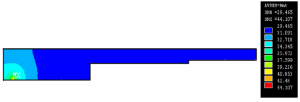PREDICTION OF TEMPERATURE DEFORMATIONS OF PARTS DURING TURNING USING DIFFERENT COOLING METHODS
Problem. The development of modern mechanical engineering is accompanied by the development of new structural, heat-resistant and wear-resistant steels and alloys with high strength properties. The mechanical processing of such materials by a point is accompanied by the occurrence of thermal deformations, leading to distortion of the dimensions of the part after turning (Fig. 1).
Fig.1. The appearance of sized temperature error after turning detail Drt
Development of optimal schemes computational and experimental approach to the prediction of temperature fields (fig. 2) and deformations in turning of details using various cooling methods can control turning precision by selecting the cooling method and (or) the correction of the tool movement.
The use of the proposed model and methods to ensure its adequacy is the basis not only for predicting the thermal deformation details to ensure the specified accuracy in turning and the basis for control and development of the thermal deformation laws movement correction tool in turning.
Fig. 2. Temperature field of the part during the turning process
For the first time, physical, mathematical and computer models for calculating thermal deformations during multi-pass turning of parts using various types of cooling have been developed.
Commercial offer.
Models are proposed for predicting thermal deformations of parts during turning to control thermal deformations and the development of laws for correcting the movement of the cutter during turning.
Publications:
- SukayloA., Kaldos A., Krukovsky P., Lierath F., Pieper H.J., Emmer T., Kundrak J., Bana V. Development and verification of a computer model for thermal distortions in hard turning // Proc. of the international conference on advances in materials and processing technologies (AMPT), Dublin, 2003, p.333-336.
- Sukaylo, Krukovsky P., Kundrak J., Emmer T. Numerical modeling of thermal strains in turning with use of different cooling methods // Resanie i instrument. 62N, 2002. pp. 119-126.


